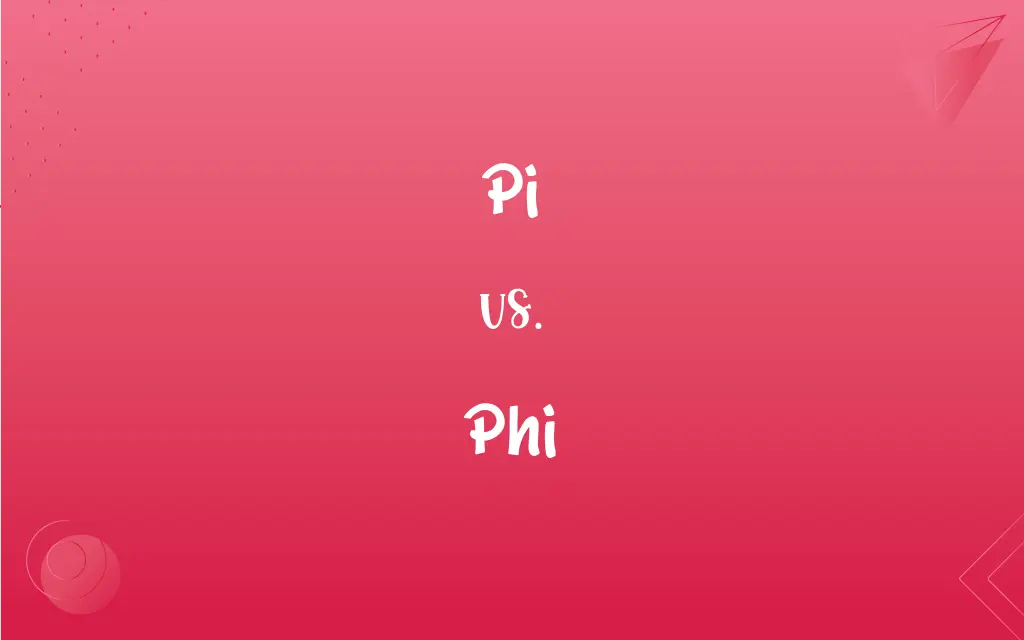Pi vs. Phi: What's the Difference?
By Aimie Carlson & Harlon Moss || Updated on March 4, 2024
Pi (π) is a mathematical constant representing the ratio of a circle's circumference to its diameter, while Phi (φ) is the golden ratio, a special number that appears in mathematics, art, and nature, symbolizing harmony and proportion.

Key Differences
Pi (π), approximately 3.14159, is fundamental in geometry for calculating the properties of circles and spherical shapes, such as circumference, area, and volume. On the other hand, Phi (φ), approximately 1.618, is known as the golden ratio, an irrational number found when a line is divided into two parts so that the whole length divided by the long part is equal to the long part divided by the short part.
While Pi is crucial in the realms of mathematics, physics, engineering, and technology for solving problems related to circular and oscillatory motions, Phi plays a significant role in art, architecture, design, and nature, often associated with aesthetics and natural proportions. For example, Pi is used to design wheels and satellites, whereas Phi is used to analyze the proportions of the Parthenon and the growth patterns of shells.
The discovery and use of Pi date back to ancient civilizations, including the Babylonians and Egyptians, who approximated Pi for architectural and astronomical calculations. Conversely, Phi became widely recognized in the Renaissance as architects and artists like Leonardo da Vinci used it to create visually appealing works.
Despite their different applications, both Pi and Phi are celebrated for their ubiquity and the mystery they add to the understanding of the universe. Pi Day is observed on March 14th (3/14), reflecting the first three digits of Pi, while the fascination with Phi is often celebrated through its application in art and design to achieve beauty and balance.
Comparison Chart
Definition
Ratio of a circle's circumference to its diameter
Golden ratio, a special number in art, mathematics, and nature
ADVERTISEMENT
Approximate Value
3.14159
1.618
Main Use
Calculations involving circles and spheres
Aesthetics in art, architecture, and nature
Historical Origin
Ancient civilizations like Babylonians and Egyptians
Known in antiquity, popularized in the Renaissance
Symbol of
Circular motion, engineering, and technology
Harmony, proportion, and beauty
Celebrated with
Pi Day on March 14th
Application in design and architecture
ADVERTISEMENT
Found in
Engineering, physics, astronomy
Art, architecture, design, nature
Pi and Phi Definitions
Pi
The constant ratio of a circle's circumference to its diameter.
Calculating the area of a circle uses Pi (πr²).
Phi
Symbolizes beauty and harmony in mathematics.
The Fibonacci sequence is closely related to Phi.
Pi
Used in physics to describe oscillatory motions.
The period of a pendulum is proportional to the square root of its length, divided by Pi.
Phi
Used in financial markets to analyze stock movements.
Traders apply Phi to predict price retracements.
Pi
(also pē) The 16th letter of the Greek alphabet. See Table at alphabet.
Phi
The golden ratio, approximately 1.618, found in aesthetics.
The dimensions of the Parthenon exhibit Phi.
Pi
(Mathematics) A transcendental number, approximately 3.14159, represented by the symbol π, that expresses the ratio of the circumference to the diameter of a circle and appears as a constant in many mathematical expressions.
Phi
Appears in patterns of growth and structures in nature.
The arrangement of leaves around a stem follows Phi.
Pi
An amount of type that has been jumbled or thrown together at random.
Phi
Represents perfect proportionality in art and design.
Many Renaissance artists used Phi to compose their artworks.
Pi
To jumble or mix up (type).
Phi
The 21st letter of the Greek alphabet. See Table at alphabet.
Pi
To become jumbled.
Phi
Φ, the 21st letter of the Euclidean and modern Greek alphabet, usually romanized as "ph".
Pi
The 16th letter of the Classical and Modern Greek alphabets and the seventeenth in Old Greek.
Phi
(mathematics) The golden ratio.
Pi
(mathematics) An irrational and transcendental constant representing the ratio of the circumference of a Euclidean circle to its diameter; approximately 3.14159265358979323846264338327950; usually written π.
Phi
A visual illusion whereby a sequential pattern of lights produces a false sense of motion.
Pi
(metal typesetting) Metal type that has been spilled, mixed together, or disordered.
Phi
The 21st letter of the Greek alphabet
Pi
(typography) pica (conventionally, 12 points = 1 pica, 6 picas ≈ 1 inch).
Pi
Piaster.
Pi
(metal typesetting) To spill or mix printing type.
Pi
(typography) Not part of the usual font character set; especially, non-Roman type or symbols as opposed to standard alphanumeric Roman type.
In computing, pi characters may be entered with special key combinations.
Pi
Pious.
Pi
A mass of type confusedly mixed or unsorted.
Pi
A Greek letter (
Pi
The letter
Pi
To put into a mixed and disordered condition, as type; to mix and disarrange the type of; as, to pi a form.
Pi
The ratio of the circumference to the diameter of a circle
Pi
Someone who can be employed as a detective to collect information
Pi
The scientist in charge of an experiment or research project
Pi
The 16th letter of the Greek alphabet
Pi
A fundamental number in trigonometry and calculus.
The sine wave equation incorporates Pi.
Pi
Essential for engineering calculations involving rotation.
Pi is used to determine the angular velocity of gears.
Pi
Represents an infinite decimal that continues without repetition.
Pi has been calculated to over a trillion digits.
FAQs
What is the significance of Pi in mathematics?
Pi is crucial for calculating the properties of circles and any engineering or physical phenomena involving circular shapes or oscillatory motion.
Why are Pi and Phi considered irrational numbers?
Both are irrational because they cannot be exactly expressed as a fraction of two integers, and their decimal representations go on infinitely without repeating.
How is Phi used in architecture?
Phi is used to achieve aesthetically pleasing proportions and balance, as seen in historical structures like the Parthenon.
How did ancient civilizations use Pi?
They used approximations of Pi for architectural designs, constructing buildings and monuments, and in some cases, for astronomical calculations.
How are Pi and Phi celebrated or recognized in culture?
Pi is celebrated on Pi Day (March 14), and Phi's aesthetic and mathematical properties are celebrated through its application in design and analysis of natural phenomena.
Are there any books or movies about Pi or Phi?
Yes, there are books and movies that explore the concepts and mysteries of Pi and Phi, such as the novel "The Da Vinci Code" for Phi and the film "Pi" directed by Darren Aronofsky, which delves into the obsession with finding patterns in Pi.
Is there a connection between Pi and Phi?
While they are used in different contexts, both Pi and Phi reveal underlying patterns in mathematics, nature, and art, showing the interconnectedness of the universe.
What role does Pi play in physics?
Pi is essential in physics for equations describing wave motion, electromagnetism, and general properties of circles and spheres in various physical contexts.
Can Pi and Phi be calculated precisely?
Both Pi and Phi are irrational numbers, meaning they cannot be precisely calculated; their decimal representations go on indefinitely without repeating. However, for practical purposes, they can be approximated to a required degree of accuracy.
Why do mathematicians and scientists find Pi and Phi fascinating?
Mathematicians and scientists are fascinated by Pi and Phi due to their widespread occurrence in nature, mathematics, and the arts, as well as their fundamental properties that connect various disciplines.
Can Pi and Phi be found in nature?
Yes, Pi appears in phenomena involving circular motion, while Phi is observed in the growth patterns of plants and the structure of natural objects.
What makes Phi known as the golden ratio?
Phi is called the golden ratio due to its unique properties of division and proportion, which have been associated with beauty and harmony in art and nature.
What are the challenges of computing Pi and Phi to many decimal places?
Computing Pi and Phi to many decimal places requires significant computational resources and algorithms capable of handling large-scale arithmetic operations efficiently.
Do Pi and Phi have practical applications in modern technology?
Yes, Pi is used in engineering and technology for designing circular objects and systems, while Phi is used in design and aesthetics to enhance visual appeal.
How do educators teach the concepts of Pi and Phi?
Educators often introduce Pi and Phi through geometry and art, using hands-on activities, real-life examples, and historical context to illustrate their importance and applications.
How do Pi and Phi influence modern design and architecture?
In modern design and architecture, Pi is used in engineering calculations for circular structures, while Phi influences aesthetic decisions, aiming to create spaces and products with pleasing proportions and harmony.
How does the Fibonacci sequence relate to Phi?
The ratio of successive numbers in the Fibonacci sequence approximates Phi as the sequence progresses, illustrating a mathematical connection between the Fibonacci sequence and the golden ratio.
What is the formula for calculating the area of a circle using Pi?
The area of a circle is calculated using the formula A = πr², where A is the area and r is the radius of the circle.
How have artists historically incorporated Phi into their work?
Artists have historically used Phi to create compositions with balanced and harmonious proportions, believing that this ratio contributes to the aesthetic appeal of their works.
What are some controversies or myths associated with Pi and Phi?
Controversies and myths include the belief that the Great Pyramid of Giza was constructed using the golden ratio (Phi), though evidence is inconclusive, and various attempts to legislate the value of Pi, reflecting misunderstandings of its mathematical properties.
About Author
Written by
Aimie CarlsonAimie Carlson, holding a master's degree in English literature, is a fervent English language enthusiast. She lends her writing talents to Difference Wiki, a prominent website that specializes in comparisons, offering readers insightful analyses that both captivate and inform.
Co-written by
Harlon MossHarlon is a seasoned quality moderator and accomplished content writer for Difference Wiki. An alumnus of the prestigious University of California, he earned his degree in Computer Science. Leveraging his academic background, Harlon brings a meticulous and informed perspective to his work, ensuring content accuracy and excellence.































































